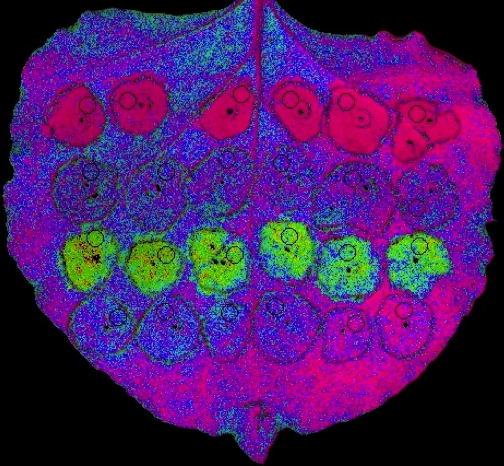Rapid gene analysis method accelerates photosynthesis studies

Throughout the growing season seemingly benign clouds pass over millions of acres of crops, causing rapid fluctuations in light intensity and inadvertently robbing these plants of their productivity—this costs us untold bushels of potential yield. In a recent study, researchers used a rapid screening technique that genetically engineers plants—in real time—to investigate how to help plants realize their full potential.
Photosynthesis is the process in which plants turn light energy and carbon dioxide into food and fuel. In full sun, plants receive more energy than they can use. The extra energy could generate damaging molecules, but instead, plants siphon this energy off as heat to protect themselves. When a cloud passes overhead, plants are slow to recover from this protective process, called non-photochemical quenching, or NPQ.
"It can take minutes to hours for the plant to fully recover and begin photosynthesizing at maximum capacity again," said lead author Krishna Niyogi, a professor at the University of California, Berkeley. "We are trying to figure out how to speed up the plant's recovery from NPQ, which models predict could increase yields by 10 to 15 percent."
Niyogi and co-authors are searching for mechanisms that plants and algae naturally evolved to recover faster from NPQ. This work was published in Plant Journal and is part of Realizing Increased Photosynthetic Efficiency, a multi-institutional research project funded by the Bill & Melinda Gates Foundation and led by the University of Illinois at the Carl R. Woese Institute for Genomic Biology.
"The method developed here will greatly accelerate the search for means to improve photosynthetic efficiency under conditions of varying light," said lead author Steve Long, Gutgsell Endowed Professor of Plant Biology and Crop Sciences at Illinois.
Before implementing this technique, they could quickly sequence the DNA of these organisms, but lacked the biological tools to quickly figure out the genes responsible for desirable traits. They would have had to spend weeks or months creating gene constructs, inserting them into plants, growing the plants, and ensuring that the gene had been expressed.
Now, in a matter of days, these researchers can compare multiple genes side-by-side on the same leaf using transient expression, a temporary technique to evaluate gene function used extensively by plant pathologists. With transient expression, the gene is expressed for a few days and then the effect on the leaf is tested.
Researchers swap out the genes from a bacterium that, in nature, produce tumorous growths on the roots of flowering plants with the genes that might speed recovery from NPQ.
NPQ is incredibly complex. At least four different mechanisms, with different rates of recovery, collectively make up NPQ. The fastest mechanism is mediated by a tug-of-war between two enzymes.
In this study, researchers evaluated how overexpressing these enzymes affected NPQ. They also evaluated three distantly related proteins (from a unicellular alga, a moss, and a small flowering plant) that are thought to activate the fastest mechanism; they found that the protein from the moss had the fastest activation and greatest capacity to recover from NPQ.
Finally, they confirmed the function of genes from two species of oceanic algae, which are emerging model organisms. One of these genes enabled the plant to produce a pigment that has been shown to improve energy transfer.
Ultimately, this technique speeds up the research process. Now researchers can use this technique to quickly identify the genes needed to increase the yields of staple food crops. Through "global access," pledged by the Bill & Melinda Gates Foundation, the outcome of this work may one day benefit smallholder farmers, especially those working to sustain their communities in Sub-Saharan Africa and Southeastern Asia.
More information: Lauriebeth Leonelli et al, Transient expression infor rapid functional analysis of genes involved in non-photochemical quenching and carotenoid biosynthesis, The Plant Journal (2016). DOI: 10.1111/tpj.13268
Journal information: The Plant Journal
Provided by University of Illinois at Urbana-Champaign




















